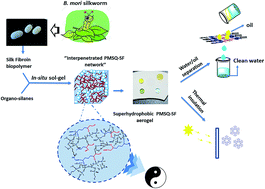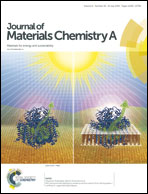Novel multifunctional polymethylsilsesquioxane–silk fibroin aerogel hybrids for environmental and thermal insulation applications†
Abstract
The development of aerogels with improved mechanical properties, to expand their utility in high-performance applications, is still a big challenge. Besides fossil-fuel based polymers that have been extensively utilized as platforms to enhance the mechanical strength of silsesquioxane and silica-based aerogels, using green biopolymers from various sustainable renewable resources are currently drawing significant attention. In this work, we process silk fibroin (SF) proteins, extracted from silkworm cocoons, with organically substituted alkoxysilanes in an entirely aqueous based solution via a successive sol–gel approach, and show for the first time that it is possible to produce homogeneous interpenetrated (IPN) polymethylsilsesquioxane (PMSQ)–SF hybrid aerogel monoliths with significantly improved mechanical properties. Emphasis is given to an improvement of the molecular interaction of the two components (SF biopolymer and PMSQ) using a silane coupling agent and to the design of pore structure. We succeeded in developing a novel class of compressible, light-weight, and hierarchically organized meso–macroporous PMSQ–SF IPN hybrid aerogels by carefully controlling the sol–gel parameters at a molecular level. Typically, these aerogels have a compressive strength (δmax) of up to 14 MPa, together with high flexibility in both compression and bending, compressibility up to 80% strain with very low bulk density (ρb) of 0.08–0.23 g cm−3. By considering these promising properties, the superhydrophobic/oleophilic PMSQ–SF aerogel hybrids exhibited a high competency for selective absorption of a variety of organic pollutants (absorption capacities ∼500–2600 g g−1 %) from water and acted as a high-performance filter for continuous water/oil separation. Moreover, they have demonstrated impressive thermal insulation performance (λ = 0.032–0.044 W m−1 K−1) with excellent fire retardancy and self-extinguishing capabilities. Therefore, the PMSQ–SF aerogel hybrids would be a new class of open porous material and are expected to further extend the practical applications of this class of porous compounds.



 Please wait while we load your content...
Please wait while we load your content...